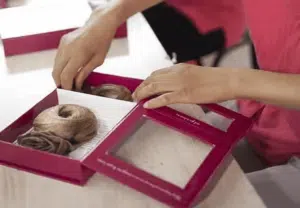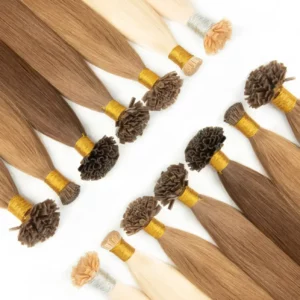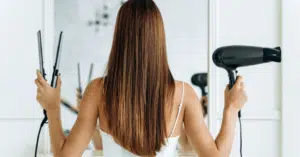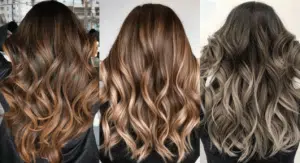You want micro-thin bonds, secure installs, and zero damage. You also want speed and repeatable results. I will show you a clean, salon-ready nano method from consultation to finish.
To fit nano hair extensions, I section with clean rows, thread pre-loaded nano rings, insert the nano tip flush to the scalp, crimp with the correct plier groove, and repeat in mirrored brick rows. I finish with blending, aftercare, and a move-up plan at 8–10 weeks.

If you are a salon owner, a wholesaler, or a pro stylist, you need a method that is simple, scalable, and kind to natural hair. Let us go step by step and remove guesswork.
What are nano hair extensions?
Clients ask for invisible bonds that feel weightless. Nanos answer that need without heat or glue.
Nano hair extensions use a tiny metal ring and a nano-sized tip. The tip is usually a fine wire or plastic filament bonded to a small strand bundle. The ring grips the natural hair without heat.

Dive deeper
What “nano” means in the chair: The ring inner diameter is very small, so the bond is discreet. A proper nano system pairs the correct ring size with the right tip core. Some brands use a metal wire core; others use a soft polymer. I match ring type to the tip core to prevent slippage and to keep pressure even. I also match strand weight to the client’s hair density. Fine clients need light strands, often 0.5–0.8 g. Medium clients can carry 0.8–1.0 g. I never overload a fragile perimeter.
Hair quality matters: I use full cuticle, single-donor hair for wear time, color accuracy, and reusability. This hair resists matting, holds tone, and survives multiple move-ups. It blends cleanly after a dry cut. It also saves my clients money over the year because I can reinstall the same hair.
Where nanos shine vs. other methods: Nanos sit flatter than most micro-rings and avoid adhesive like tape. They are great for parting versatility and ponytails. They are slower than tape for bulk volume days, but nanos win where micro invisibility and flexible styling matter.
| Feature | Nano rings | Tape-ins | Keratin (U tip) |
|---|---|---|---|
| Bond size & visibility | Ultra small, very discreet | Flat, may show in high movement | Small but fused, needs removal heat |
| Install speed | Moderate | Fast | Slower |
| Reuse & move-up | High (8–10 weeks) | High (6–8 weeks, adhesive care) | Moderate (re-tip if needed) |
| Heat/Glue used | No heat, no glue | Adhesive | Heat bonds |
| Ideal clients | Fine to medium density | Volume/length quickly | Long wear, precise strand control |
How to fit nano hair extensions?
A clean map beats speed. I set sections first, then the install moves fast and neat.
I start with a scalp and density check, map rows, pre-load rings on a loop tool, pick small, consistent natural hair sections, insert nano tips fully, then crimp once with the right groove. I finish in brick rows and blend.
Dive deeper
Prep and mapping: I wash with a clarifying shampoo and no conditioner at the roots. I dry smooth because frizz hides inconsistent section sizes. I map 2–4 rows at the back, then 1–2 rows on each side, staying at least two fingers above the hairline and at least one finger behind the perimeter to hide bonds. I use a brick-lay pattern so upper bonds cover lower gaps. I leave natural hair out around the parting and hairline for coverage.
Tools and ring choice: I use nano rings that match the tip core. For metal-wire nano tips, I use silicone-lined nano rings to cushion the wire and reduce slip. For soft-core nano tips, I use non-lined micro nano rings with tighter inner diameter. I keep a color set to match the root for invisibility.
The crimp: I load rings on a threader. I take a natural hair slice equal to the strand weight. I slide the ring onto the natural hair, insert the nano tip until the top sits snug under the ring’s edge, then I crimp once with the middle plier groove. I never double-crimp. I check for rotation; the strand should pivot but not slide. I test tension with a gentle tug. If it slides, I remove and redo—never over-crimp a bad bond.
Row flow: I start low back, center out. I check symmetry left/right every 4–5 bonds. I keep spacing even (about 5–7 mm) to avoid bulk and to allow easy scalp access for washing. I avoid cowlick zones and very short nape hairs.
Finish and blend: I dry cut with point-cutting and slide-cutting. I connect lengths and remove steps, especially at sides. I give aftercare in writing and book the move-up at 8–10 weeks.
Nano ring hair extensions before and after



How to put nano hair extensions in yourself?
People want a DIY shortcut. I respect that desire, but I also protect their hair.
Self-install is risky because section sizes and tension control are hard without training. I do not recommend full DIY. If a client must, I suggest a small, temporary filler and a pro check-in.
Dive deeper
Why I advise pro installs: Nanos look simple, but consistency matters. Uneven section size creates slip or stress. Mis-matched ring and tip compressions cut cores or break natural hair. Poor mapping causes visible bonds in ponytails. A stylist sees crown whorls, perimeter weaknesses, and density changes that a mirror misses.
If someone insists on limited self-work: I set clear rules. Only place a few filler strands behind the ears for a one-night event. Use pre-bonded nano tips from a reputable source with identical diameter. Use a silicone-lined nano ring for cushion. Never place near the hairline or crown. Keep tension low. Crimp once only. Remove within one week using a proper opener plier. Do not wash aggressively. Avoid oils at the root. Book a salon for full installation and mapping.
Safer alternatives for home: I steer clients to clip-ins or halos for temporary wear. Those give volume without root pressure. For long projects like bridal season, I tell clients to plan a pro nano install early and maintain it with scheduled move-ups. Hair health first; revenue follows when clients trust our guidance.
How many nano rings for a full head?
Strand count drives time and cost. I size it to density, head size, and goals.
Most full heads use 120–180 nano strands at 18–22 inches. Finer hair may need 100–140 strands; thick or big heads can reach 180–220. I always test with a mini row first.
Dive deeper
My sizing steps: I confirm the target length and the client’s natural density. I choose strand weight per density: 0.5–0.8 g for fine, 0.8–1.0 g for medium. Then I do the math. If I want two back rows of 30–40 each, plus two side rows of 20–30 each, I end near 120–140. For glam volume and length on a large head, I add a third back row or extend the side rows, moving into 160–180+. I keep balance so sides do not overtake back density.
Why I do a test row: A mini row shows slip risk, scalp sensitivity, and immediate blend. If the client has seasonal shedding or a sensitive scalp, I lower strand weight and increase spacing. I do not chase “more” if the scalp says “enough.”
Wholesale planning: For salons and brands, I build standard pack lists by density tiers. This keeps ordering simple and inventory lean. For example, “Fine Volume Set = 120 × 0.6 g,” “Standard Glam Set = 160 × 0.8 g,” “Max Set = 200 × 1.0 g.” It keeps cost predictable and install times consistent across teams.

Maintenance and move-up for nano extensions?
Nanos last when clients follow simple rules from day one. I give written care.
Clients brush from ends up, use a root-safe shampoo, keep conditioner mid-lengths down, sleep in a loose braid, avoid root oils, and return every 8–10 weeks for a move-up.
Dive deeper
Daily care: I recommend a soft detangling brush and a loop brush near bonds. I tell clients to detangle morning and night, starting at the ends and moving upward with the other hand supporting just below the bonds. They must dry the root after washing; sleeping on wet bonds invites tangling. I allow light, leave-in conditioner from mid-lengths down and a touch of serum on the ends.
Wash routine: I use sulfate-aware shampoo at the root with gentle finger pads. No circular scrubbing. I rinse thoroughly, then condition from mid-lengths. I avoid heavy oils near the bonds. If the client has hard water, I plan a gentle chelating wash monthly and a moisture mask mid-lengths down. Minerals can dull color and increase friction; chelation resets slip and shine.
Move-up schedule: I schedule 8–10 weeks for most clients. Fast growers may need 6–8. At move-up, I open the ring, slide out the strand, comb out shed, clarify, and reinstall with a fresh ring. I inspect the nano tip core; if crushed or bent, I replace or re-tip. I track strand losses; more than 5–10% between appointments means I adjust section sizes or ring type.
Common mistakes and how to avoid them?
Most problems come from three things: bad mapping, wrong ring/tip match, and over-tension.
I avoid these by planning rows, sizing sections to density, matching ring to tip core, crimping once with the right groove, and teaching aftercare clearly with written steps.
Dive deeper
Mistake 1: Over-tension. It feels secure on day one but creates soreness and micro-breakage. I hold the natural hair and tip aligned, keep the ring near the scalp with a 2–3 mm cushion, and crimp once. If the client reports pain after 24 hours, I loosen problem bonds.
Mistake 2: Wrong ring choice. Metal-wire cores need silicone-lined rings to reduce cutting. Soft-core tips need a tighter, non-lined ring to prevent spin. I keep both in stock, color-matched.
Mistake 3: Section size mismatch. A heavy strand on too little natural hair will slip or stress. I match grams to density and test with a tug. Consistency is king; I use a small guide tool or simply train my eye with repeatable slice thickness.
Mistake 4: Perimeter exposure. Bonds show in up-styles if rows sit too low or too far forward. I keep two fingers’ distance from the hairline and use shorter strands at the temple for a soft, believable edge.
Mistake 5: Product at the root. Heavy oils migrate into rings and reduce grip. I educate clients and send a simple PDF care sheet. Clarity avoids callbacks and saves the relationship.
My opinion
I build long-term business on hair health, consistency, and honesty. Nanos are powerful because they are light, flexible, and discreet. They shine with full cuticle hair that resists friction and keeps tone. They require discipline in mapping, section sizing, and ring matching. When salons document installs, send written aftercare, and book timely move-ups, clients stay for years. Cheap shortcuts feel good for a week; premium systems feel good all year. I choose premium.
FAQ
Are nano hair extensions good for fine hair?
Yes, when I use lighter strands and gentle spacing. I avoid heavy grams on fragile areas.
How often should clients move up nanos?
Every 8–10 weeks for most clients; 6–8 for fast growth or very fine hair.
Do nano rings damage hair?
Not when installed with correct section size, ring choice, and tension, plus proper home care.
Can clients color with nanos installed?
I color away from the bonds. I protect bonds and avoid oxidative chemicals at the ring area.
How many strands do I need?
Most full heads need 120–180. I test with a mini row to confirm.
What about swimming and workouts?
Clients should rinse after salt/chlorine, dry the root, and braid before intense activity.
Conclusion
Nanos deliver invisible bonds, healthy wear, and repeatable results—when you map well, match ring to tip, control tension, and maintain on schedule.





